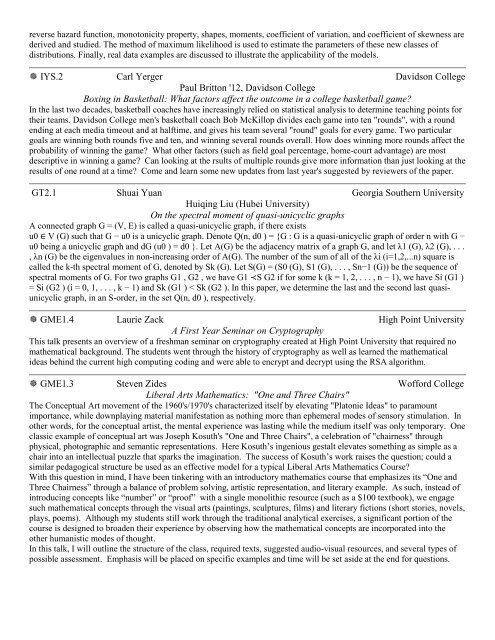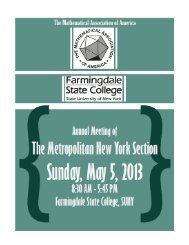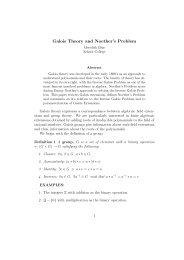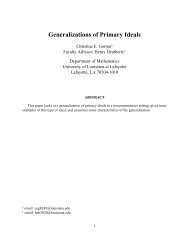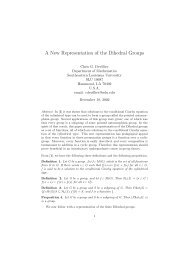Presentation Abstracts - MAA Sections
Presentation Abstracts - MAA Sections
Presentation Abstracts - MAA Sections
Create successful ePaper yourself
Turn your PDF publications into a flip-book with our unique Google optimized e-Paper software.
everse hazard function, monotonicity property, shapes, moments, coefficient of variation, and coefficient of skewness are<br />
derived and studied. The method of maximum likelihood is used to estimate the parameters of these new classes of<br />
distributions. Finally, real data examples are discussed to illustrate the applicability of the models.<br />
IYS.2 Carl Yerger Davidson College<br />
Paul Britton '12, Davidson College<br />
Boxing in Basketball: What factors affect the outcome in a college basketball game?<br />
In the last two decades, basketball coaches have increasingly relied on statistical analysis to determine teaching points for<br />
their teams. Davidson College men's basketball coach Bob McKillop divides each game into ten "rounds", with a round<br />
ending at each media timeout and at halftime, and gives his team several "round" goals for every game. Two particular<br />
goals are winning both rounds five and ten, and winning several rounds overall. How does winning more rounds affect the<br />
probability of winning the game? What other factors (such as field goal percentage, home-court advantage) are most<br />
descriptive in winning a game? Can looking at the rsults of multiple rounds give more information than just looking at the<br />
results of one round at a time? Come and learn some new updates from last year's suggested by reviewers of the paper.<br />
GT2.1 Shuai Yuan Georgia Southern University<br />
Huiqing Liu (Hubei University)<br />
On the spectral moment of quasi-unicyclic graphs<br />
A connected graph G = (V, E) is called a quasi-unicyclic graph, if there exists<br />
u0 ∈ V (G) such that G − u0 is a unicyclic graph. Denote Q(n, d0 ) = {G : G is a quasi-unicyclic graph of order n with G −<br />
u0 being a unicyclic graph and dG (u0 ) = d0 }. Let A(G) be the adjacency matrix of a graph G, and let λ1 (G), λ2 (G), . . .<br />
, λn (G) be the eigenvalues in non-increasing order of A(G). The number of the sum of all of the λi (i=1,2,...n) square is<br />
called the k-th spectral moment of G, denoted by Sk (G). Let S(G) = (S0 (G), S1 (G), . . . , Sn−1 (G)) be the sequence of<br />
spectral moments of G. For two graphs G1 , G2 , we have G1 ≺S G2 if for some k (k = 1, 2, . . . , n − 1), we have Si (G1 )<br />
= Si (G2 ) (i = 0, 1, . . . , k − 1) and Sk (G1 ) < Sk (G2 ). In this paper, we determine the last and the second last quasiunicyclic<br />
graph, in an S-order, in the set Q(n, d0 ), respectively.<br />
GME1.4 Laurie Zack High Point University<br />
A First Year Seminar on Cryptography<br />
This talk presents an overview of a freshman seminar on cryptography created at High Point University that required no<br />
mathematical background. The students went through the history of cryptography as well as learned the mathematical<br />
ideas behind the current high computing coding and were able to encrypt and decrypt using the RSA algorithm.<br />
GME1.3 Steven Zides Wofford College<br />
Liberal Arts Mathematics: "One and Three Chairs"<br />
The Conceptual Art movement of the 1960's/1970's characterized itself by elevating "Platonic Ideas" to paramount<br />
importance, while downplaying material manifestation as nothing more than ephemeral modes of sensory stimulation. In<br />
other words, for the conceptual artist, the mental experience was lasting while the medium itself was only temporary. One<br />
classic example of conceptual art was Joseph Kosuth's "One and Three Chairs", a celebration of "chairness" through<br />
physical, photographic and semantic representations. Here Kosuth’s ingenious gestalt elevates something as simple as a<br />
chair into an intellectual puzzle that sparks the imagination. The success of Kosuth’s work raises the question; could a<br />
similar pedagogical structure be used as an effective model for a typical Liberal Arts Mathematics Course?<br />
With this question in mind, I have been tinkering with an introductory mathematics course that emphasizes its “One and<br />
Three Chairness” through a balance of problem solving, artistic representation, and literary example. As such, instead of<br />
introducing concepts like “number” or “proof” with a single monolithic resource (such as a $100 textbook), we engage<br />
such mathematical concepts through the visual arts (paintings, sculptures, films) and literary fictions (short stories, novels,<br />
plays, poems). Although my students still work through the traditional analytical exercises, a significant portion of the<br />
course is designed to broaden their experience by observing how the mathematical concepts are incorporated into the<br />
other humanistic modes of thought.<br />
In this talk, I will outline the structure of the class, required texts, suggested audio-visual resources, and several types of<br />
possible assessment. Emphasis will be placed on specific examples and time will be set aside at the end for questions.


